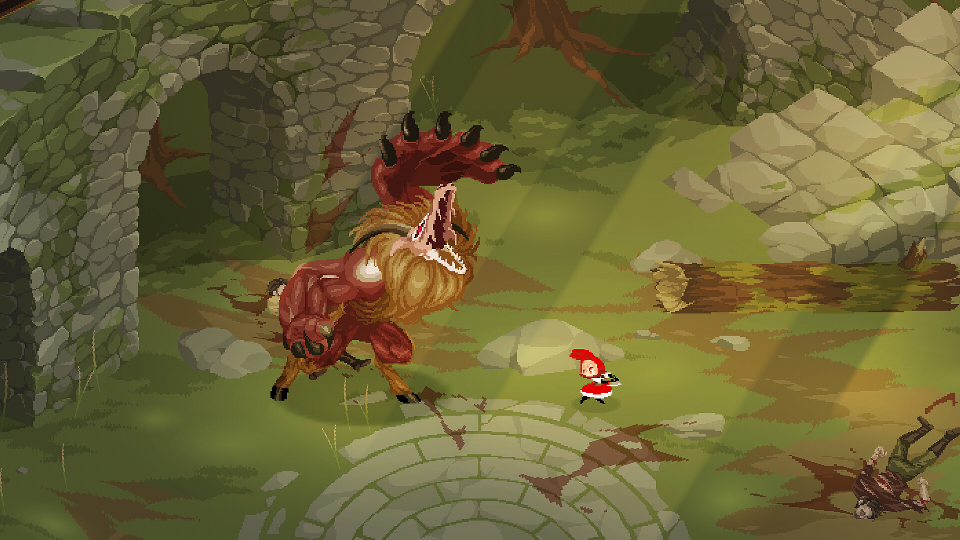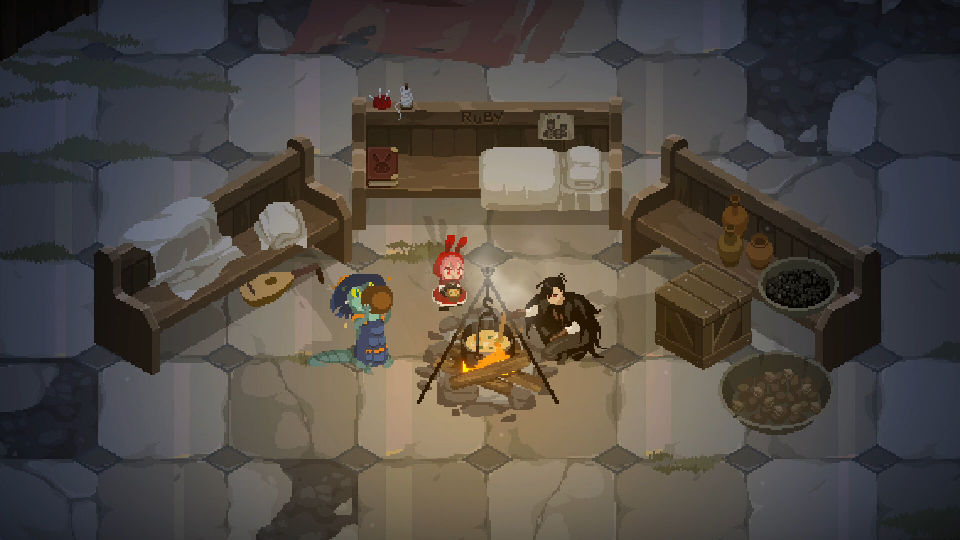
Written by Jared T. Hooper on 31 Oct 2024
Purchasing a truckload of video games over the years only to discover a title and I don't click after picking up the controller, assuming I pick it up in the first place, has enlightened me on the godsend that is the demo. Having that first date with a game has helped my wallet not feel as empty as it usually is, but there's a demo I played recently I unfortunately wasn't able to open my wallet for, and that's for the upcoming Souls-like boss rush Rubinite.
Story
As far as the story goes, it's not much different from your typical video game story: a bad guy does a bad thing, so the protagonist journeys to get revenge. There is more to Rubinite's story than anything in Mario, say, which has a story insofar as giving the tubby plumber an excuse to hop off his hairy Italian tush. For instance, some brief exchanges between the protagonist, Ruby, and her companions, an anthropomorphic gecko and Nite Owl from Watchmen. Now, there shouldn't be much more to comment on with what little the demo presents, yet that hasn't stopped me from penning an additional three paragraphs.
In between boss battles, we catch snatches of Ruby's mother speaking to her in presumed flashbacks, but we only discern her from her back-lit silhouette. From the flowering shape of her gown, knowing the setting is your usual medieval-era fantasy, I offhandedly thought, “...Is Ruby royalty?” and it was a momentary stroke of non-verbal brilliance, something most players probably wouldn't notice or realize until a later reveal, when Ruby's lineage turns into an important plot point. And then that later reveal takes place thirty seconds later, when the gecko-man remarks, “Gee, PRINCESS, bet your palette ain't used to this peasant food, innit?”
Actually and technically, that reveal took place on the game's website and the Steam page, which I didn't read because I have the attention span of a two-year-old and hinge my gaming interests on how pretty the artwork is, but given how upfront the game and advertising are about this particular, it makes me weary about how close the narrative's holding its plot points to its chest. If Ruby's identity as a princess is a freebie, what other cards will the narrative just lay out without any tricks or style? And even if Ruby's former societal position is irrelevant to the events that transpire, when the story lays out the pieces of a puzzle only to give up the ghost without any incentive, it's at best repetitious and at worst condescending.
Mind, since the story is barely past its first act, as much as I like to believe I have good instincts on a story's ultimate merit, it's not fair for me to be ringing the foul buzzer. For all I know, telling us Ruby's a princess could be a ploy, and I'm playing right into the narrative's hands for the late-game twist that Ruby was just an orphaned beggar all along and the flashbacks are memories implanted by the big bad to manipulate her. I've experienced plenty of stories that went from being exceedingly lackluster to perplexingly enthralling. Tales of Arise and Kuzumi-kun, Can't You Read the Room? come to mind, the former going from a bad-guy-of-the-week short story collection that spoon-feeds exposition with whatever bloke is loitering around the town gate to Xenoblade Chronicles, and the latter starting off as a repetitive romcom and ending as one of the most gripping romances I've read to date. Rubinite could fall into this camp or another. Heck, 95% of the story of Momodora: Reverie Under the Moonlight is “the kingdom's gone to hell in a handbasket, oh no,” but it has an ending that still to this day has me shook. My full review might be a lamentation on how Rubinite's third act put me in therapy.
Combat
Despite my reservations on the story's ultimate grade, honestly, the combat is what I picked this game up for. Like Shadow of the Colossus, but without the solemn introspection between battles, the only enemies in Rubinite are the bosses, and any and all practice you get with the controls is right in the frying pan.
If the Souls-like tag on Steam is an indication, this game's not easy. I died to the tutorial boss after the training wheels were let off, and according to a Twitter post by the developers, the collective player base has died nearly six times their victories over the first two bosses combined. The lack of common enemies to practice on did at first make me a touch anxious about popping my cherry on the mad cow-diseased Minotaur, but games like Xenoblade Chronicles 3 have made me somewhat resentful toward common enemies because many combat systems operate best in long-term battles, and oversized armadillos tend to keel over before your party can get the ball rolling. So even though Rubinite baptizes you by fire, you're permitted the time and space to go all out and hit your stride, that wondrous flow state where everything clicks together, your hands become the controller, and you melt into the game.

Rubinite's combat is fast-paced like Hyper Light Drifter, but while I would describe the latter's combat as hit-and-run tactics, Ruby's clashes against monsters are more like matador matches, wherein you stand and wait for your enemy to storm, only to perform a chicuelina out of the way before closing in with the estocada. There's this constant tension as you await their charge, wondering if you'll successfully evade, if it's time yet to step in for the kill, and then all that tension explodes when you do go for that fatal thrust. That tension also evaporates if you fail your evasion, because the combat has a high-risk, high-reward system, where the longer you wait to strike, the more damage you'll deal, but a longer wait is more chances for your foe to reset your charge-up. You do technically have the ability to just wail on them willy-nilly, but basic attacks do paltry damage and, frankly, don't feel as good or as satisfying to pull off. They do feel great when you reach the midpoint of the battle, when the boss falls to their knees, and the game grants you express permission to go ham with the catharsis that makes Skyward Sword's Koloktos a fan favorite.
The controls are so tight and the game juice so juicy that my first of two criticisms of the combat is that it's so fast-paced that it was common I took hits when I swore I pressed the dodge button, though, seeing as this is a hiccup I've encountered across multiple games, it's either combat's missing equivalent of coyote time or just a me problem. The latter, I imagine, as this mild frustration diminished with rematches.
My other criticism is that an intro cutscene plays at the start of every boss battle, even on retries. You do have the option to skip it, which does only take two seconds, but that's two seconds that would be saved if retries simply cut out the cutscenes.
Other Stuff
A lightning round of miscellany, starting with Ruby's kit.
Even though Ruby is plenty fearsome in her own right, you can upgrade her using the spoils from bosses, namely by pinning her with talismans similar to the charms from Hollow Knight. The number of talismans available in the demo is limited, the most you can wear at once being two, and the differences to stats or effects they provided, I found, was incremental. Maybe if you deck Ruby out in the late-game will you feel more akin to the behemoths you combat, but at this early stage, the most I got out of a badge was surviving one extra hit or stunning a boss for a second, if that.
Ruby also has skill trees, but those aren't available in the demo, so I can't comment on them.
The pixel art is gorgeous. Let's get that out of the way.
After the demo ends, you have the option of rematching both available bosses. I didn't plan to and just wanted to poke around those menu options, but as soon as you select a boss to rematch, the game assumes you're committed and won't let you return to the main menu. The only way to do that is to officially begin the battle and then pause and quit to the main menu. A back button would go a long way toward conveniencing the player.
To end this section on a good note, in spite of this game's darker nature, it's got some charm going, mainly in its advertising. After beating the demo, Ruby's on her knees praying for players to wishlist the game on Steam, and on the Steam page itself, she'll mark the options for players to Wishlist and Follow the game but drops into that same praying animation so that they don't hit the Ignore button.

Conclusion
The demo took me about an hour to beat, which is about what I expected, but I got so used to JRPG demos, which let you play the first 6+ hours, that when the Rubinite demo wrapped up, I was like, “Wait, that's it?” and was still hungry for more. Rubinite's slated release date is a broad 2025, and while trailer footage and screenshots suggest the game is mostly done, or at least a sizable chunk of it is, there's no telling how great the gulf will be between playing the demo and playing the final product, so I'm hoping there's a practice mode or something similar that'll allow demo players to refresh their skills and knowledge of the controls (the boss rematches might be this refresher course already) or else they'll fight the third boss like they dipped their hands in melted butter beforehand.
All said and done, the Rubinite demo samples us with tense, excellently paced combat and a glimpse into a dark fantasy world with more than it lets on, and I've no doubt the final product will be an indie gemstone.


Just writing about the video games that tickle my fancy when the fancy strikes.
posted by Ross Liversidge on 27 Nov 2025
posted by Ross Liversidge on 21 Nov 2025
posted by Ross Liversidge on 16 Oct 2025
posted by Ross Liversidge on 14 Oct 2025
posted by Ross Liversidge on 10 Oct 2025
posted by Ross Liversidge on 30 Sep 2025
posted by on 12 Sep 2025